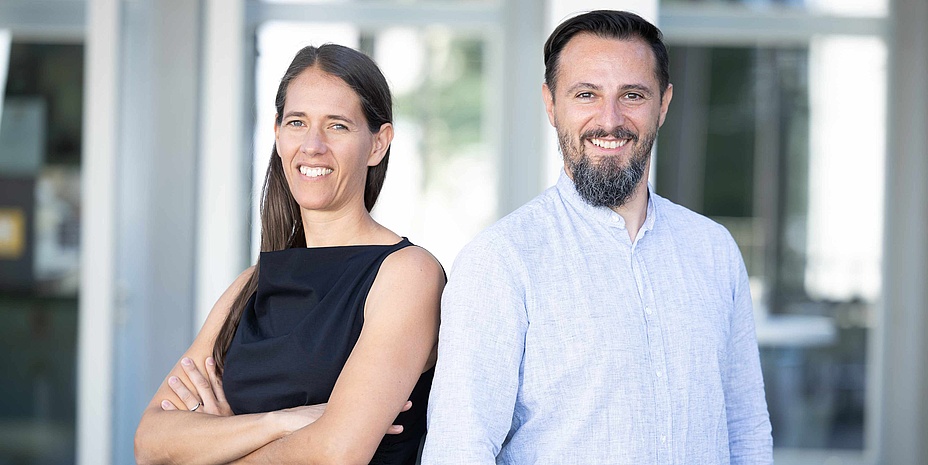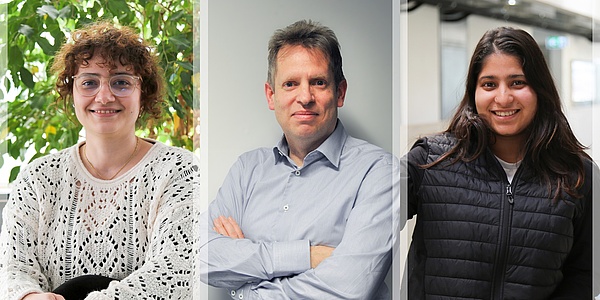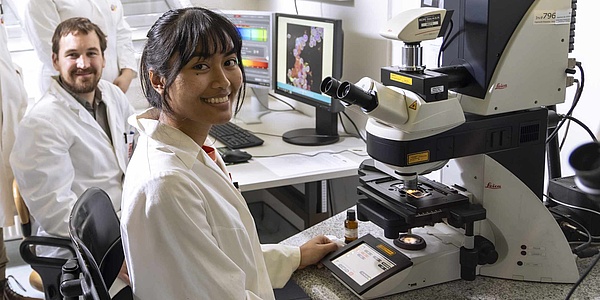‘Believe in Your Ideas!’

TU Graz people: Congratulations on the ERC Grant! What does the ERC grant mean for you and your career?
Therese Rienmüller: The ERC Grant is a great honour for me and at the same time a unique opportunity. It gives me the freedom to strengthen my field of research and my research group at TU Graz and to pursue very challenging project ideas that would otherwise be difficult to fund. For my career, it means that I can position myself more internationally and build up my research team sustainably.
How long did you work on the application? Did you also take part in the TU Graz ERC Club meetings?
Rienmüller: I started attending the ERC meetings at TU Graz, the ERC Clubs, more than a year before the submission. These meetings were very helpful for me to understand the process, especially the multi-stage procedure. We were given valuable tips on what to look out for when submitting our applications. After that, I spent about a year thinking intensively about possible topics and studying the literature to sharpen up the idea. I started the actual writing in March. From this point onwards, I dedicated myself to this work in a very focused way.
Can you briefly describe your project or idea?
Rienmüller: This is a basic research project. The idea is that we can obtain a better picture of the success of therapy in in vitro cultures of brain cells after a mechanical trauma by combining various measurement data with the help of AI, adapt the therapy if necessary or make predictions about the success of the therapy.
What first steps are you taking now?
Rienmüller: First of all, I want to recruit the right team members to bring together the different expertise for the project. At the same time, I am starting to set up the experimental infrastructure and data pipelines so that we can start the planned experiments and analyses efficiently. As a next step, I am planning the first pilot experiments together with my collaboration partner Muammer Ücal from the Medical University of Graz.
Where do you do your research at TU Graz? And why is your research best conducted at this institute and not elsewhere?
Rienmüller: I work at the Institute of Biomechanics. My project is about the effect of mechanical trauma on cells. The Institute of Biomechanics is intensively involved in research into craniocerebral trauma and the biomechanics of the brain. The head of the institute, Gerhard Holzapfel, received an ERC Synergy Grant last year. The infrastructure and support are therefore in place at this institute in order to successfully manage such a large research project.
What advice would you give to researchers who would also like to apply for an ERC grant?
Rienmüller: Start on time. It’s a lot more work than you might think. I can also highly recommend watching the tutorial videos provided by the ERC. They give you an inside view of what reviewers expect from an application. I also recommend reading successful applications from recent years.
TU Graz people: Congratulations on the ERC Grant! What does the ERC grant mean for you and your career? You have also received almost a quarter of a million euros to purchase a fluorescence microscope with a magnetic control unit.
Robert Winkler: The ERC Starting Grant gives me the opportunity to pursue my own scientific vision. Many exciting follow-up ideas already emerged during the application process. The ERC Grant will enable me to establish a new field of research at TU Graz that combines scientific innovation with social benefit.
Can you briefly describe your project or idea?
Winkler: In a nutshell, we print microrobots smaller than a tenth of a hair. And in more detail, in the PRINTBOT project, we are expanding our 3D nanoprinting method so that we can seamlessly combine several materials in one structure – the prerequisite for producing functional microbots. These microbots are equipped with magnetic propulsion and nano-tools such as heating antennas or miniaturised containers to perform tasks such as precise heating or targeted transport.
Did you also take part in the TU Graz ERC Club meetings?
Winkler: Unfortunately, I couldn’t attend the meetings due to scheduling issues, but the input from ERC grantees, the ERC Club and my institute colleagues was extremely valuable for the pitch. Something I’m very grateful for.
How long did you work on the application?
Winkler: I already had the idea for the microbots using FEBID during my doctoral thesis. However, this was still too much science fiction at the time because 3D printing technology was still in its infancy and there were many unresolved issues. The basic idea for the microbots then grew in the back of my mind for about eight years. In Harald Plank’s CD lab, we then took 3D nanoprinting technology to the point where the visions seemed feasible. However, the actual application process was highly intensive and stressful right up to the last minute.
What first steps are you taking now?
Winkler: First, I’ll put a motivated team together (two PhDs, master’s students) and procure the necessary additional equipment. I am looking forward to implementing the first steps, the multi-material 3D nano print, together.
Where do you do your research at TU Graz? And why is your research best conducted at this institute and not elsewhere?
Winkler: I conduct research on 3D printing using the so-called FEBID technique (Focused Electron Beam Induced Deposition) at the Institute of Electron Microscopy and Nanoanalysis. The FELMI-ZFE is perfectly equipped in terms of infrastructure and expertise when it comes to nanostructures and analysis on small scales. In addition, a new focused ion beam system was put into operation this summer, which will be essential for PRINTBOT.
What advice would you give to researchers who would also like to apply for an ERC grant?
Winkler: My most important piece of advice is start planning early. Attend information events, talk to people with ERC experience and define the content framework in good time. Finally, believe in your ideas – even if they seem risky at first.
Detailed information on the ERC projects
This article introduces current ERC grant holders Theresa Rienmüller and Robert Winkler. In the TU Graz people cover story, you can also read the article ‘ERC Grants: Welcome to the Champions League of Basic Research’ and the article ‘From Application to Funding: Your Journey with the R&T House’.
You can find this article and other articles to browse through in TU Graz people #94, the magazine for TU Graz employees and interested parties.




